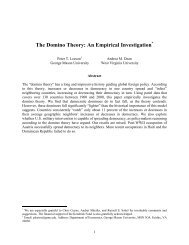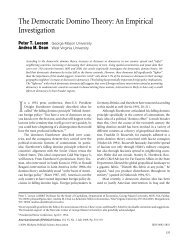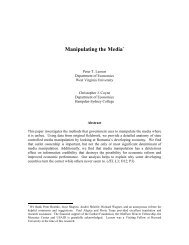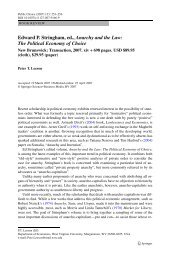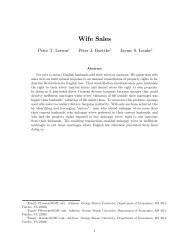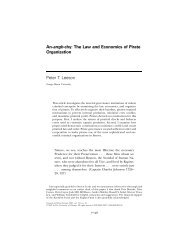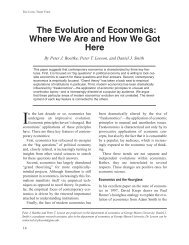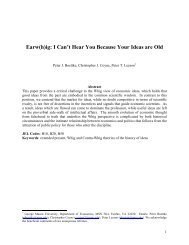Human Sacrifice - Peter Leeson
Human Sacrifice - Peter Leeson
Human Sacrifice - Peter Leeson
Create successful ePaper yourself
Turn your PDF publications into a flip-book with our unique Google optimized e-Paper software.
natural shock seek to plunder those whose expected wealth is higher. If con‡ict’s cost is<br />
su¢ ciently high, it’s cheaper for communities to protect their property rights by destroying<br />
part of their wealth. Wealth destruction depresses the expected payo¤ of plunder and in<br />
doing so protects rights in wealth that remains.<br />
<strong>Human</strong> sacri…ce is a method of such destruction. By exchanging valuable property for<br />
humans and then slaughtering them, communities destroy wealth. <strong>Human</strong> sacri…ce is a highly<br />
e¤ective vehicle for destroying wealth to protect property rights because it’s an excellent<br />
public meter of wealth destruction.<br />
Unlike burning a mound of crops, human sacri…ce is spectacular, communicating a sacri…cing<br />
community’s wealth destruction far and wide. This permits would-be predators<br />
who don’t observe destruction directly to learn of it nonetheless. Further, unlike burning<br />
a mound of crops, which can be manipulated to appear to destroy more wealth than is in<br />
fact destroyed, immolating a live human is nearly impossible to fake. This ensures would-be<br />
predators that seemingly destroyed wealth is in fact destroyed.<br />
To incentivize community members to contribute wealth for destruction, human sacri…ce<br />
is presented as a religious obligation. Persons who believe that they must contribute valuable<br />
property toward the purchase of sacri…cial victims to procure divinities’good favor are more<br />
likely to do so.<br />
The logic my theory develops isn’t limited to understanding the practice of human sacri…ce.<br />
It illuminates a wide variety of behavior seemingly at odds with the economic maxim<br />
“more is preferred to less”— from the mundane to the extraordinary. For example, it helps<br />
explain why some persons who live in unsafe neighborhoods drive cheaper cars than persons<br />
with similar incomes who live in safer ones; why many businesses in developing economies<br />
deliberately eschew growth; why persons in ancient societies expended inordinate resources<br />
building monumental tombs, such as pyramids; and why these same persons buried their<br />
most valuable goods with the dead. Each of these behaviors is marked by what might be<br />
called “conspicuous destruction”: persons deliberating choosing to make themselves poorer<br />
than they could otherwise be.<br />
Such destruction is especially striking where we …nd groups of persons pursuing outright<br />
poverty. For example, James Scott (2009) documents this pursuit among the Zomia people of<br />
3



